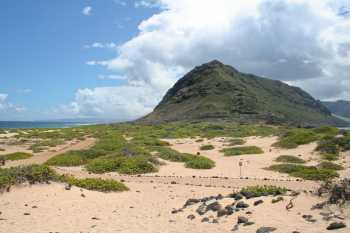After four years of permitting and planning, the predator-proof fence at Ka`ena Point Natural Area Reserve on the island of Oahu, Hawaii, USA has finally begun construction and is expected to be completed in January 2011.
This fence comes none too soon after almost a quarter of the Laysan Albatross nests last year were lost to predation. The approximately 600-m long marine-grade stainless steel fence will stand two metres tall and will run along the base of the mountain away from view of the ocean. Because the reserve is a small peninsula, a design that would block the peninsula without encircling it was chosen in order to minimize the possibility of bird strikes.

Ka`ena Point Natural Area Reserve is one of the most important protected areas in Hawaii because of its wealth of natural and cultural resources. It is home to one of the most accessible albatross colonies in the World and has Laysan Albatrosses Phoebastria immutabilis, Wedge-tailed Shearwaters Puffinus pacificus and White-trailed Tropicbirds Phaethon lepturus breeding within its boundaries, in addition to 11 endangered plant species.
However, even with thrice-weekly predator control, up to 15% of albatross fledglings are killed by predators each year. Additionally, 14 species of seabirds are regularly seen from shore around Ka`ena Point and it is expected that we could see the establishment of two to three new species of seabirds within several years of the fence, including Black-footed Albatrosses Phoebastria nigripes, which are regular visitors.
Most importantly, because Ka`ena Point is on a high island, it will provide a safe breeding site for many seabird species if albatross nesting habitat in the Northwestern Hawaiian Islands is lost to projected sea level rises (click here).

The type of fencing being used will exclude non-native predatory animals from as small as a two-day old mouse all the way up to the larger ungulates, and will prevent these animals from digging under or climbing over it (click here for details of the fence design).
The use of predator-proof fencing is anticipated to increase the effectiveness of existing predator control efforts, shifting the focus from reducing predator numbers to eradication. The fencing will make it feasible to remove all non-native predatory animals from within the fenced area and to focus control efforts on the shoreline rather than across the entire peninsula. Predator removal efforts are expected to begin in January 2011 to correspond with the low point in the rodent breeding season.
For more information, visit the Ka'ena Point Ecosystem Restoration Project at www.restorekaena.org and click here for the project's Final Environmental Assessment.
Click here for an earlier ACAP news item on the albatrosses of Ka'ena Point.
Lindsay Young, ACAP North Pacific News Correspondent, 28 November 2010

 English
English  Français
Français  Español
Español